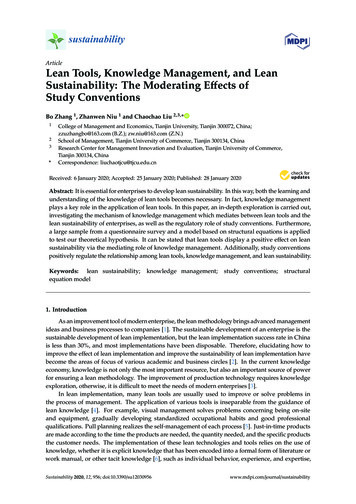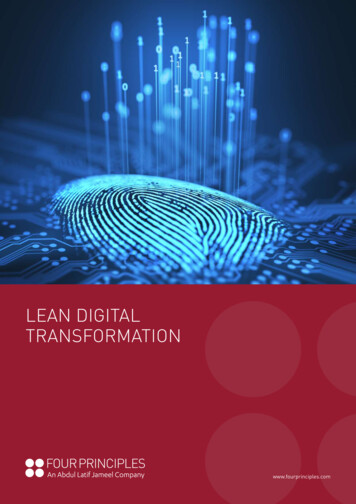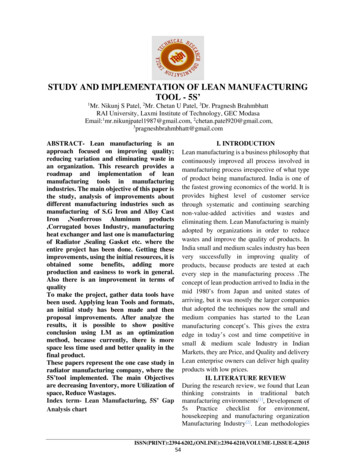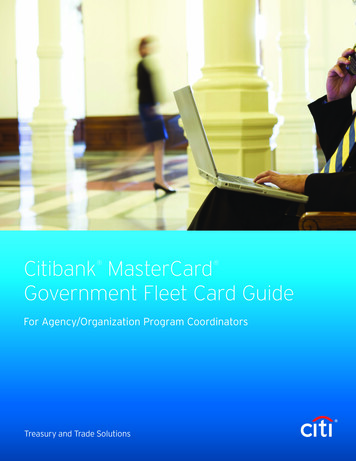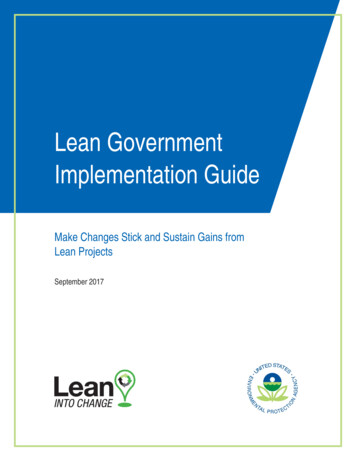
Transcription
Lean GovernmentImplementation GuideMake Changes Stick and Sustain Gains fromLean ProjectsSeptember 2017
OTHER PUBLICATIONS FROM THE LEAN GOVERNMENT INITIATIVELean in Government Starter KitLean and Information Technology ToolkitLean Leadership GuideLean Government Event Scoping GuideLean Government Methods GuideLean Government Metrics GuideLean Transference PrimerCase studies and other information about EPA and State Lean activities are available at the EPA Leanwebsite (www.epa.gov/lean).Lean Government Implementation GuidePage i
TABLE OF CONTENTSIntroduction . 1What Is Lean Implementation and Why Focus on It? . 2What to Expect in Lean Implementation . 5Implementation Step-By-Step Guide . 8A. Set Up for Success. 8B. Develop an Implementation Plan . 15C. Complete and Track Actions . 19D. Measure and Evaluate Results . 22E. Standardize and Socialize Process Changes . 25F. Celebrate and Share Success. 30G. Manage Change and Avoid Pitfalls . 37Conclusion . 41Lean Government Implementation GuidePage ii
This page is intentionally blank.Lean Government Implementation GuidePage iii
INTRODUCTIONThis Lean Government Implementation Guide is designed to help agencies successfully manage one ofthe more difficult aspects of process improvement—follow-up and implementation. This work beginsafter you decide how to improve your process. The focus of this Guide is on Lean, which is animprovement philosophy and set of methods that seek to eliminate non-value added activity or “waste”from processes. Environmental agencies use Lean to deliver higher quality, faster, and less costlyprograms and services that protect human health and the environment. You can use this Guide whetheryou are conducting a rapid improvement event or using a different Lean method to improve yourprocess. This Guide is most applicable to a team lead or implementation manager, but can also providerelevant background information to other staff or managers involved in Lean project implementation. Inthis Guide, “Lean event” refers to a rapid improvement event or “kaizen” event, which is a 2-5 dayperiod when a team analyzes a process and makes changes to create a new, more efficient way to work.This Implementation Guide contains guidance,tips, and resources to help you:1. Understand the importance of planningfor implementation associated with Leanevents and projects2. Learn strategies and actions to takeduring and after Lean events or projectmeetings to get better and moresustainable results3. Support successful Lean implementationefforts and address commonimplementation challengesLEAN GOVERNMENT IMPLEMENTATIONGUIDE KEY CONTENT What Is Lean Implementation and Why Focuson It?What to Expect in Lean ImplementationImplementation Step-By-Step GuideA. Set Up for SuccessB. Develop an Implementation PlanC. Complete and Track ActionsD. Measure and Evaluate ResultsE. Standardize and Socialize Process ChangesF. Celebrate and Share SuccessG. Manage Change and Avoid PitfallsConclusionThis Guide is a product of the U.S. EnvironmentalProtection Agency’s Lean Government Initiative (www.epa.gov/lean) and supplements the Lean inGovernment Starter Kit, which provides guidance and practical resources on how environmentalagencies can use Lean to improve their operations.Lean Government Implementation GuidePage 1
WHY DO I NEED A LEAN IMPLEMENTATION GUIDE?As a Lean manager or implementer, you may be asking yourself:Why do I need an Implementation Guide? Isn’t the Lean event what matters?Rapid improvement events drive dramatic improvements as teams identify ways to eliminate handoffs,rework, delays, and other wastes that slow down and complicate processes.However, identifying these process changes is just the beginning. Implementing a new process during andafter the Lean event takes work. Despite your best intentions, it is all too easy to go back to the way youdid things before.This Guide will help you think proactively about the “implementation” phase of Lean and give you step-bystep guidance and tools to make sure you realize the full potential from your Lean project.Even when a Lean project does not involve a rapid improvement event, the tips and resources in this Guidecan help you keep on track with process improvements. What Is Lean Implementation and Why Focus on It?What Do We Mean by Lean Implementation?Environmental agencies are using a range of process-improvement methods, including Lean methods, tospeed processes, provide better services, and focus staff time on “mission-critical” work. Lean uses a“Plan-Do-Check-Act” (PDCA) problem-solving framework to support continual improvement (see Figure1). The PDCA problem-solving framework provides a scientific, systematic approach for addressingcontinuous improvement that can be used toFigure 1: Plan-Do-Check-Act Problem-Solving Frameworkguide the execution of projects. In this Guide,we refer to Lean implementation or Leanfollow-up as the Do, Check, and Act phasesof this cycle – that is, what happens after a4. Determine3. Set ImprovementRoot CauseTargetsteam or individual plans how to improve aprocess. In the context of Lean events,5. Develop2. Describe CurrentCountermeasuresConditionsimplementation includes developing animplementation plan, making changes to6. Enact1. Clarify theCountermeasuresProblemimprove the process, monitoring results andadjusting the process as necessary, sharingproject successes, and related activities.Lean projects that use rapid improvementevents include three main components: Planning and preparing for theevent, including scoping the event,developing the charter, assemblingLean Government Implementation GuidePage 2PlanDoActCheck8. Standardize,Sustain, andShare Success7. Measure andEvaluate Results
the team, arranging logistics, and conducting background research. These activities align withthe “Plan” phase in PDCA. Holding the team-based event, including mapping the current process, designing a new process,implementing changes to improve the process, and developing an implementation plan forremaining improvements. These activities align with the “Plan” and “Do” phases in PDCA. Following up from the event to implement the new process and implementation plan, verifyand evaluate results including at 30-, 60-, and 90-day report-out meetings, and sustain andshare project successes. These activities align with the “Do,” “Check,” and “Act” phases in PDCA.Figure 2: Key Components of a Rapid Improvement EventThis Guide builds from the Lean in Government Starter Kit discussion of follow-up and implementation.Why Focus on Implementation?Implementation sounds simple, but lack of sufficient follow through can be a key reason for failure ofLean projects. Three reasons why follow-up is critical to the success of Lean projects include:1. Without follow-up, a Lean effort may result only in plans for improvement, not actual results. Animplementation plan or new process design does not mean much if it is not acted upon.2. Without follow-up, any process changes made during and following an event or projectmeetings (e.g., changes to the organization of a work area in a 5S event) will be at risk ofbacksliding. The tendency will be for things to go back to the way they always have been.3. Without follow-up, you and others may miss opportunities for additional improvements to thetarget process or other processes. Lean follow-up communications can help raise awarenessabout Lean and encourage greater success.Lean Government Implementation GuidePage 3
KEY FOLLOW-UP ACTIVITIES AFTER LEAN PROJECTSThe implementation team leader and project team should coordinate the following key follow-up actions afterLean projects with oversight by the project sponsor. Complete action items in the implementation plan.Conduct training and outreach on the new process.Measure and report on key performance indicators to compare process performance to targets.Evaluate the effects of process changes, and identify countermeasures to address any issues.Standardize and share successful practices.Ideally, your organization will periodically conduct targeted process-improvement projects, such as rapidimprovement events, to address pressing problems, and will develop a culture of continualimprovement using the Plan-Do-Check-Act cycle in which everyone is looking for ways to makeefficiency or quality gains in their day-to-day work. Lean projects can reduce processing times andprocess steps by 50 percent or more. Regular improvement activities can also add up over time togenerate significant gains. In this best-case scenario, the improvement curve might look something likethe following diagram.Figure 3: Process Improvement Curve over Time with Rapid Improvement Events and Ongoing ImprovementsProcess ImprovementsDaily rtunately, Lean implementation does not always meet this picture in practice, and lack of sufficientattention to follow-up is one key reason. As illustrated in Figure 4, unless you dedicate adequateattention to follow-up and implementation, your process may backslide or you may shortchangeadditional improvements.Lean Government Implementation GuidePage 4
RapidImprovementEventNo Figure 4: Common Problems with Lean Event Implementation: Lack of Continued Improvement and eWhat to Expect in Lean ImplementationIn the Implementation Step-by-Step Guide that follows this chapter, we provide guidance and resourcesfor each of the following critical areas for implementation to make follow-up easier and more effective.A. Set Up for Success. Successful follow-up starts with effective planning, preparation, andexecution of the Lean project. Keep implementation in mind as you scope and set goals for yourproject, and make sure that leadership is involved from the start. Develop clear, realistic goalsand objectives for your project, and start or even complete implementation during a rapidimprovement event or project meetings. Ensure that your project involves process stakeholdersand achieves buy-in from staff and managers. Setting up for success is part of the “Plan” phaseof the PDCA framework.B. Develop an Implementation Plan. When your project team identifies a new “future state”process design, the team should develop an implementation plan for how to put it into practice.A well-designed implementation plan—with clear assignments for who will implement actionitems, by when, and lines of accountability—will facilitate effective follow-up. Developing animplementation plan is part of the “Do” phase of the PDCA framework.C. Complete and Track Actions. Making sure that follow-up activities happen and generate desiredresults requires accountability. This involves: (1) leadership that expects results and removesbarriers to achieve them; (2) a team leader who makes sure staff execute actions on time; and(3) a structured process for tracking progress and addressing implementation challenges.Completing and tracking actions also represent the “Do” phase of the PDCA framework.D. Measure and Evaluate Results. Not only will your project team need to carry out the actions inthe implementation plan, it will also need to measure and evaluate how those actions changethe performance of the process. At regular intervals, compare the performance of the processon key performance indicators to baseline data before your team made improvements.Measuring and evaluating results is central to the “Check” phase of the PDCA framework.Lean Government Implementation GuidePage 5
E. Standardize and Socialize Process Changes. To put the new process your team designed intoplace, your team will need to communicate the new process to those involved in the process,both inside and outside the agency. This can involve developing simplified process maps,refining standard work, and training employees on new procedures. To sustain theimprovements over time, you’ll need to periodically evaluate your efforts and identify when toreinforce process changes and/or look for new improvement opportunities. Standardizing andsocializing process changes is part of the “Act” phase of the PDCA framework.F. Celebrate and Share Success. It is important to highlight the successes that your agency hasachieved with Lean and share your project experience so others can learn from it. Develop apresentation and visually appealing documentation of your project to help tell your story, andacknowledge your project team’s work. Identify what process changes could be appliedelsewhere and share those approaches with others. Celebrating and sharing successes is alsopart of the “Act” phase.G. Manage Change and Avoid Pitfalls. Many people involved in the process (especially those whodid not participate in on the project team or in the event) will resist change, and the naturaltendency will be to go back to easier, business-as-usual practices. To combat this tendency,strategies you can take to manage change and avoid follow-up pitfalls include: starting follow-upearly, effectively managing expectations, creating capacity to carry out follow-up, engaging yoursponsor and employees, communicating frequently, and exhibiting patience in the improvementeffort. Managing change and avoiding pitfalls is a critical part of sustaining gains in the “Act”phase of the PDCA framework.Table 1. Lean Implementation Steps and the PDCA Problem-Solving FrameworkPDCA PHASEPlanDoCheckActIMPLEMENTATION STEPSet Up for SuccessDevelop an Implementation PlanComplete and Track ActionsMeasure and Evaluate ResultsStandardize and Socialize Process ChangesCelebrate and Share SuccessesManage Change and Avoid PitfallsFollow-up is often simple in concept, but hard in practice. The box below summarizes key actions in theImplementation Step-by-Step Guide that follows this chapter.Lean Government Implementation GuidePage 6
KEY IMPLEMENTATION ACTIONSScoping and Planning Improvement Efforts (see Set Up for Success): Engage Leadership throughout your project, ensuring that sponsors help develop the project charter, attendthe kick-off, report-out, and management briefings in the event, and oversee follow-up activities Set clear goals and objectives for your Lean project Schedule 30-, 60-, and 90-day follow-up meetingsDuring Improvement Events or Project Meetings (see Develop an Implementation Plan): Accomplish as much implementation as you can during the event or project meetings Create an implementation plan that clearly identifies follow-up actions and responsibilities Schedule implementation team check-in meetings and project progress meetings with the project sponsorAfter Developing an Implementation Plan (see Complete and Track Actions, Measure and Evaluate Results,Standardize and Socialize Process Changes, and Celebrate and Share Success): Hold weekly meetings to make progress on implementation, and monthly meetings to report to management Track follow-up actions using color-coding in your implementation plan Track metrics to measure results Communicate process changes to internal staff and external parties Celebrate the team’s success and identify solutions that could be shared elsewhereLean Government Implementation GuidePage 7
IMPLEMENTATION STEP-BY-STEP GUIDEA. Set Up for SuccessYour Lean team can do several things early on inprojects to make Lean implementation easier andmore successful. These include establishing keyroles for implementation, setting clear goals andexpectations, and focusing on implementationduring events and project meetings (therebycreating less need for follow-up!).STEPS TO SET UP FOR SUCCESS Step 1: Establish Key Roles for LeanImplementationStep 2: Set Clear Goals and Expectations forYour Lean ProjectStep 3: Maximize Implementation DuringLean EventsStep 1: Establish Key Roles for LeanImplementationThere are four key roles for guiding Lean projects through their successful completion: Sponsor: The sponsor is the executive who leads the charge for process improvement andsupports the Lean project from start to finish. Sponsors both enable Lean teams to be successfuland hold them accountable to produce results. Without effective leadership, Lean often fails. Facilitator: In a rapid improvement event, the facilitator works with the team to properly scopethe Lean project, and facilitates discussions during the event to ensure the team understandsthe current process, identifies and implements process changes to address root causes ofproblems, and develops an implementation plan for follow-up after the event. Implementation Team Leader: Under oversight of the sponsor, the team leader manages dayto-day implementation of process changes after the Lean event, or throughout theimprovement effort if the project did not involve a rapid improvement event. The team leaderdoes not do all the follow-up, but organizes others involved to make sure it gets done. Team Member: Team members serve as foot soldiers working with the implementation teamleader to improve the process. Team members participate in project team meetings and take onassigned actions and tracking duties to implement process changes.Identify your project’s sponsor and select a facilitator early in the planning and scoping phase, since thesponsor and facilitator have key roles in developing the project charter. Often, the team leader for theLean event or project will continue as the team leader during implementation, but you may want todesignate someone else instead and/or identify one or two others to assist the team lead. Confirmresponsibilities for managing implementation when you develop your implementation plan (typicallyduring an event). Team member participation involves a longer-term commitment than the duration ofthe rapid improvement event or once solutions are identified. Team members are critical to carrying outaction items to put the new process in place.Lean Government Implementation GuidePage 8
Table 2: Lean Implementation RolesRoleActivitiesSponsorPlanning/Scoping Phase: Help develop the Lean project charter, including identifying goals and objectives, settingthe scope, and recommending participants. Authorize the Lean project. Approve staff time for planning, Lean event (if applicable), and follow-up. Communicate project direction.Lean Event or Other Process Improvement Activities: Participate and provide input at the project kick-off and final report-out presentation. Attend management briefings during the event (e.g., daily) OR participate fully in theevent. Reiterate project goals/objectives and encourage the team to succeed. If your project is not a rapid improvement event, participate in management briefings andmajor project team meetings throughout the improvement effort.Follow-Up Phase: Keep the team accountable for results and implementation of process changes (e.g.,where appropriate, engage with management of participants that have a significant role inimplementation). Demonstrate commitment to full implementation and keep the team motivated Participate in routine check-ins with the Implementation Team Leader (e.g., weekly or biweekly 15-minute stand-up meetings). Attend major follow-up meetings (i.e., 30-day, 60-day, 90-day, 6-month, 1-year, etc.) toreview process performance data and discuss project progress with the project team. Help make implementation successful by removing barriers when needed (e.g., reducingcompeting demands on staff time).FacilitatorPlanning/Scoping Phase: Facilitate the pre-event scoping meeting or meetings. Work with the team to develop the Lean project charter, select the team, and prepare forthe event.Lean Event or Other Process Improvement Activities: Facilitate the Lean event, including working with the team to:o Map the current and desired future state of the process.o Identify and, if possible, implement process changes (e.g., develop standard work).o Develop an implementation plan for follow-up after the event.o Prepare for the event report-out presentation. If your project is not a rapid improvement event, facilitate project meetings to guide theteam to analyze and improve the process using Lean or other methods.Follow-Up Phase: If requested, facilitate major follow-up meetings.Lean Government Implementation GuidePage 9
RoleActivitiesImplementationTeam LeaderLean Event or Other Process Improvement Activities: Participate in the Lean event and the development of the implementation plan. If your project is not a rapid improvement event, participate in project team meetings tomake changes to improve the process and organize follow-up items that cannot beimplemented immediately into an implementation plan.Follow-Up Phase: Organize and facilitate weekly project stand-up meetings or other check-ins to make surethe team is on track with follow-up items. Participate in routine check-ins with the project sponsor (e.g., weekly or bi-weekly 15minute stand-up meetings). Encourage the team to make progress with implementation and help troubleshoot followup when needed (elevate issues to the sponsor or other senior managers if needed). Track progress with implementation, and keep the implementation plan or other actiontracking tool up to date. Organize the team for major follow-up meetings with management. Ensure that data on key process performance metrics are collected at regular intervals,reported to the project sponsor and other key managers, and shared with agency-wideresults tracking systems, such as EPA’s Lean Results Tracking System.Team MemberLean Event or Other Process Improvement Activities: Participate in the Lean event and the development of the implementation plan. If your project is not a rapid improvement event, participate in ongoing efforts to identifyand implement improvements, including project team meetings.Follow-Up Phase: Participate in project team meetings with the implementation team leader. Make changes to improve the process by carrying out actions in the implementation plan. Monitor, evaluate, and communicate the results of process changes, based on assignedduties.Tips for Identifying Individuals for These Roles Sponsor. Involve the highest level sponsor you can who will also be able to invest the time tomake the project a success, particularly in scoping the project, attending at least portions of theLean event or other project team meetings and all major follow-up meetings, and holding theteam accountable for results. Facilitator. Selecting a skilled Lean facilitator is critical to successful Lean projects. Choosesomeone who knows Lean concepts and tools, is familiar with Lean in office or governmentcontexts, has people skills to effectively manage groups, and has experience facilitatingsuccessful projects. The Lean in Government Starter Kit has tips for how to select a facilitator. Implementation Team Leader. Your implementation team leader should be someone fromwithin the process who played an active role in the Lean effort. Select someone with goodorganization and communication skills, who can help keep the project team on track and thesponsor apprised of progress. Supervisors will likely need to take responsibilities off the plate ofthe team leader to ensure there is adequate time to support the process-improvement work.Lean Government Implementation GuidePage 10
Team Members. Your project team for implementation will often be similar to the original Leanproject team, but should focus on individuals needed to execute the implementation plan andmonitor progress. Coordinate with appropriate supervisors to make sure that team membersunderstand the time commitment and have the time to participate in improvement activities.Step 2: Set Clear Goals and Expectations for Your Lean ProjectIt may not seem like a follow-up strategy,but having clear goals and expectationsfor Lean projects is essential for success,both for determining how you willimprove your process and forimplementing the process changes. Yourteam will develop goals and objectivesfor your Lean project through a LeanProject Charter. This charter will helpyour team to do the following, amongother things:Figure 5: EPA Lean Team Charter Template Clarify the scope of the project,including any boundaryconditions for the types ofprocess changes that the projectteam should consider. Forexample, your team may limitthe scope of the project to aparticular segment or aspect ofthe process, or you may decide that certain changes (e.g., regulatory changes or capitalintensive IT improvements) will not be considered. Delineate aspirational goals and use metrics to set specific, measurable objectives for yourproject prior to identifying solutions or holding a rapid improvement event. Express yourobjectives in terms of changes you would like to see in key metrics related to your process,setting targets such as a percent reduction in the total lead time for your process. The bestobjectives are S.M.A.R.T.: specific, measurable, actionable, realistic, and time-bound. Set expectations for pre-work and baseline data collection before the event or kick-off of theimprovement effort and follow-up meetings. Many charters outline the activities that the teamwill conduct prior to the event or initial project team meetings, including plans for collectingbaseline data about the process. The charters also often set the schedule (or tentative schedule)for major follow-up meetings, so that managers and team members can make advance plans. Allow for engagement of senior management in project design. The facilitator should workclosely with the sponsor and team leader to develop a draft charter. The sponsor, facilitator, andteam leader all sign and approve the charter, and help to socialize it with the rest of the projectteam. Having the signatures on the charter empowers the project team to operate within theLean Government Implementation GuidePage 11
boundaries of the document, and socializing the charter with leaders and team members priorto launching the improvement effort ensures there is agreement with its contents.Identify participants for the Lean project and any outside support you may need. The charteridentifies the full team who will participate in the Lean event, or otherwise in the effort toidentify improvements. For a rapid improvement event, you may want to identify otherindividuals who may be available to provide “on-call” support during the event. if needed (e.g.,to answer questions, provide technical expertise, or make decisions). WHAT HAPPENS IF YOU LAUNCH A PROCESS IMPROVEMENT EFFORT WITHOUT DOING ALLTHE RIGHT PREP WORK?Although not ideal, if you have not done everything to set yourself up for success for implementation, not all islost. Problem solve with your team to identify how you can get back on track. Examples include: Failure to Get Charter Signed by All Parties: The charter is a critical way to get leadership buy-in onyour project. In general, you should not do a project without leadership support. You can use the startof the Lean event, or the first project team meeting, to review, revise, and get additional signatures onthe charter, if needed. If you need additional leadership support after designing the future stateprocess, consider getting approval on the implementation plan. Insufficient Current State Data Collected: You may be able to collect some process performance dataduring a rapid improvement event if you did not collect data beforehand. If more research is neededto establish a baseline, add a task of collecting baseline data for key metrics to the implementationplan. Provide clear expectations for who should collect data, and when and where to report it.With a robust, detailed charter that your sponsor and team have agreed upon, you will have a strongfoundation for a successful project. You will also want to use the charter development process to makesure the sponsor and Lean project participants understand the steps of Lean implementation, includingexpectations for their involvement in follow-up activities after the event occurs or improvements haveotherwise been identified.Tips for Setting Clear Goals and Expectations Project sponsors should provide direction as well asmotivation for projects. Your project sponsor should beclosely involved in the development of the charter, and thenempower your team to find its own solutions within thescope and boundary conditions of the project. Be realistic about the commitment for all project phases.This tip is especially relevant for rapid improvement eventswhere, despite the name, much of the work often occursafter the event as the team puts the new process in place.Your team can m
Daily Continual Improvement. Time Process Improvements. Unfortunately, Lean implementation does not always meet this picture in practice, and lack of sufficient attention to follow-up is one key reason. As illustrated in Figure 4, unless you dedicate adequate attention to follow-up and i



